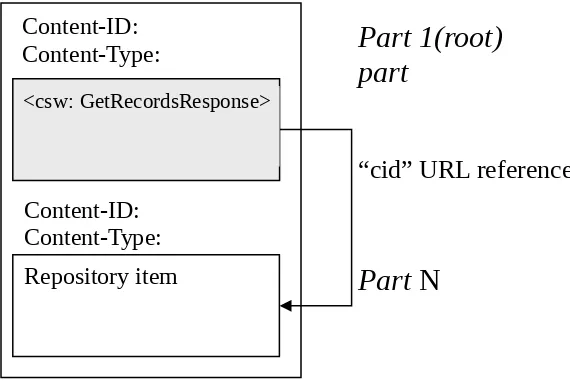Open Geospatial Consortium
OGC Doc
09-135xx-xxx
For HELP on using this form, see bottom of this page or look at the pop-up text over the symbols.
Proposed change affects: AS Imp Spec X Best Practices Paper Other
Title: Encode the metadata in a GetRecords response
Source: Frederic Houbie and Fabian Skivee
Work item code: Date: 2009-09-21
Category: C
Use one of the following categories: F (Critical correction)
A (corresponds to a correction in an earlier release) B (Addition of feature),
C (Functional modification of feature) D (Editorial modification)
Detailed explanations of the above categories can be found in the TC Policies and Procedures.
Reason for change: Current specification does not allow retrieving the metadata in the GetRecords response. When a client wants to retrieve all the metadata matching some criteria, he has to perform a GetRecords and then a GetRepositoryItem for each result. This leads to a large number of request/responses that could be avoided by piggybacking the metadata to the GetRecords response.
Summary of change: Add a new mode allowing to return the metadata along with the RegistryObject in a GetRecords response. This mode will be only activated when the parameter elementSetName is equal to “full”.
Consequences if not approved:
To retrieve all the metadata matching some criteria, a client of a CSW-ebRIM service will perform a GetRepositoryItem request for each result of the GetRecordsResponse.
Clauses affected: Section 10.3
Other specs Other core specifications Affected: Abstract specifications
Best Practices Document Supporting Doc.
Other comments:
OGC 08-089r2
Status
Disposition
Add the following text at the end of the section 10.3
If the elementSetName attribute in the request has the value “full”, the response shall include the repository items. When including repository items, the multipart/related content type [RFC 2387] shall be used. Multipart media types such as this one are intended for compound messages that consist of several interrelated parts; such entities comprise a ‘root’ part plus any number of other parts. The encoding of the RepositoryItem follows the same convention that in Section 15.2.2 “Insert Statement”.
If the outputFormat attribute in the request is present and has a value different than “multipart/related”, the GetRecords response shall not include the repositoryitems.
An XML document with the csw:GetRecordsResponse element (or a SOAP envelope) as the root element shall be included in the body of the root part. A repository item is included in a message part, with the Content-Type and Content-ID headers of that part set as shown in Figure X.
Figure X – A multipart request message
The Content-ID header field shall be used to uniquely identify MIME entities in each message part. For each extrinsic object in the root part (for which a repository item exists), the
wrs:repositoryItemRef element shall have an xlink:href attribute, the value of which is a URL conforming to the ‘cid’ scheme. The URL value refers to a specific body part of a message as described in RFC 2392.
Copyright © 2008 Open Geospatial Consortium, Inc. All Rights Reserved. 2
Content-Type: multipart/related; boundary=gc0p4Jq0M2Yt08; type=”application/xml”
Content-ID: Content-Type:
Content-ID: Content-Type:
Part 1(root)
part
Part
N
“cid” URL reference
Repository item
OGC 08-089r2
Example Using a ‘cid’ URL to refer to a part having Content-ID = <132d2g457af3@domain2.domain1>.
<wrs:ExtrinsicObject id="eo-1" mimeType="application/xml"> <wrs:repositoryItemRef xlink:type="simple"
xlink:href="cid:132d2g457af3@domain2.domain1" /> </wrs:ExtrinsicObject>
Note A ‘cid’ URL value has the form of a URL-encoded addr-spec from RFC 822.
The XML-binary Optimized Packaging (XOP) convention may be used as an alternative packaging format for constructing multipart requests. Although XOP constructs are generally used in SOAP bindings, the use of SOAP is not required. A multipart XOP package shall be created and processed as specified in the W3C XOP specification. A conforming implementation shall support multipart requests constructed in this manner.
A XOP package shall be contained within a multipart/related message structure, and the Content-Type header of the root part shall have the value “application/xop+xml”. The href attribute of the xop:Include element must be a valid URI in accord with the ‘cid’ URL scheme.
Example Using a ‘cid’ URL to refer to a repository item in a XOP package.
<wrs:ExtrinsicObject id="eo-1" mimeType="application/xml"> <wrs:repositoryItem>
<xop:Include href="cid:132d2g457af3@domain2.domain1" /> </wrs:repositoryItem>
</wrs:ExtrinsicObject>
